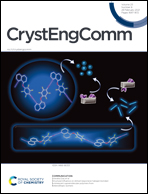Mechanical study of a copper dietary supplement, copper glycinate hydrate†
Abstract
Dietary supplementation is prevalent in our daily life, in which tablet form plays an important role due to its long-term stability and cost-effectiveness. In the pharmaceutical industry, coordination polymer-based tablets are widely produced for dietary supplementation. The mechanical properties of such dietary supplements are very crucial for the tableting process and need to be broadly studied. In this study, the mechanical properties of a copper supplement, namely copper glycinate hydrate (Cu[O2CCH2NH2]2·H2O), have been studied via high-pressure synchrotron powder X-ray diffraction and density functional theory calculations. This material is a 1D coordination polymer, and adjacent chains are linked via hydrogen bonding in the structure. The measured bulk modulus (Ko) is ∼13.9 GPa, which is comparable to that of small organic drug crystals and far smaller than that of inorganic dietary supplements. The calculated Young's moduli (13.55–35.75 GPa) indicate a significant elastic anisotropy, and the directional dependent Young's modulus can be substantiated with the underlying atomic structure. Our experimental and calculated results provide useful quantitative information for tableting and formulating this dietary supplement in the pharmaceutical industry.

- This article is part of the themed collection: Coordination Networks


 Please wait while we load your content...
Please wait while we load your content...